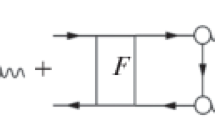Abstract
The covariant particle-vibration coupling model within the time-blocking approximation is employed to supplement the relativistic random phase approximation (RRPA) with coupling to collective vibrations. The Bethe—Salpeter equation in the particle—hole channel with an energy-dependent residual particle—hole (ph) interaction is formulated and solved in the shell-model Dirac basis as well as in the momentum space. The same set of coupling constants generates the Dirac—Hartree single-particle spectrum, the static part of the residual ph interaction, and the particle-phonon coupling amplitudes. This approach is applied to a quantitative description of damping phenomenon in even—even spherical nuclei with closed shells 208Pb and 132Sn. Since phonon coupling enriches the RRPA spectrum with a multitude of ph ⊗ phonon states, a noticeable fragmentation of giant monopole and dipole resonances is obtained in the examined nuclei. The results are compared with experimental data and results of the nonrelativistic approach.
Similar content being viewed by others
References
P. Ring, Prog. Part. Nucl. Phys. 37, 193 (1996).
D. Vretenar, A. V. Afanasjev, G. A. Lalazissis, and P. Ring, Phys. Rep. 409, 101 (2005).
Y. K. Gambhir, P. Ring, and A. Thimet, Ann. Phys. (N.Y.) 198, 132 (1990).
G. A. Lalazissis, D. Vretenar, and P. Ring, Eur. Phys. J. A 22, 37 (2004).
G. A. Lalazissis, M. M. Sharma, P. Ring, and Y. K. Gambhir, Nucl. Phys. A 608, 202 (1996).
J. Meng and P. Ring, Phys. Rev. Lett. 77, 3963 (1996).
G. A. Lalazissis, D. Vretenar, and P. Ring, Phys. Rev. 69, 017301 (2004).
G. A. Lalazissis, D. Vretenar, and P. Ring, Nucl. Phys. 650, 133 (1999).
P. Ring, Z.-Y. Ma, N. Van Giai, et al., Nucl. Phys. A 94, 249 (2001).
N. Paar, P. Ring, T. Nikšić, and D. Vretenar, Phys. Rev. C 67, 034312 (2003).
A. Ansari, Phys. Lett. B 623, 37 (2005).
E. Litvinova and P. Ring, Phys. Rev. C 73, 044328 (2006).
V. I. Tselyaev, Yad. Fiz. 50, 1252 (1989) [Sov. J. Nucl. Phys. 50, 780 (1989)].
S. P. Kamerdzhiev, G. Ya. Tertychny, and V. I. Tselyaev, Phys. Part. Nucl. 28, 134 (1997).
V. I. Tselyaev, Phys. Rev. C 75, 024306 (2007).
E. V. Litvinova and V. I. Tselyaev, Phys. Rev. C 75, 054318 (2007).
G. A. Lalazissis, J. König, and P. Ring, Phys. Rev. C 55, 540 (1997).
E. Litvinova, P. Ring, and V. Tselyaev, Phys. Rev. C 75, 064308 (2007).
S. Shlomo and D. H. Youngblood, Phys. Rev. C 47, 529 (1993).
P. Adrich, A. Klimkiewicz, M. Fallot, et al., Phys. Rev. Lett. 95, 132501 (2005).
ReferenceInput Parameter Library, Version 2, http://www-nds.iaea.org/RIPL-2
V. I. Tselyaev, Izv. Ross. Akad. Nauk, Ser. Fiz. 64, 541 (2000).
D. Sarchi, P.-F. Bortignon, and G. Colo, Phys. Lett. B 601, 27 (2004).
Author information
Authors and Affiliations
Corresponding author
Additional information
The text was submitted by the authors in English.
Rights and permissions
About this article
Cite this article
Litvinova, E., Ring, P. & Tselyaev, V. Covariant response theory beyond RPA and its application. Phys. Atom. Nuclei 70, 1380–1385 (2007). https://doi.org/10.1134/S1063778807080108
Received:
Issue Date:
DOI: https://doi.org/10.1134/S1063778807080108



